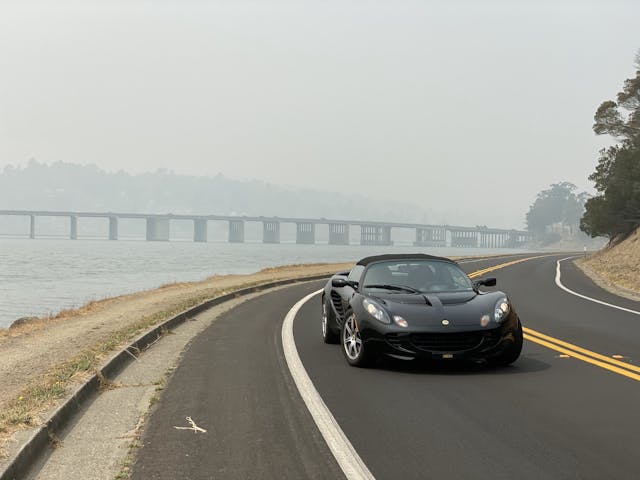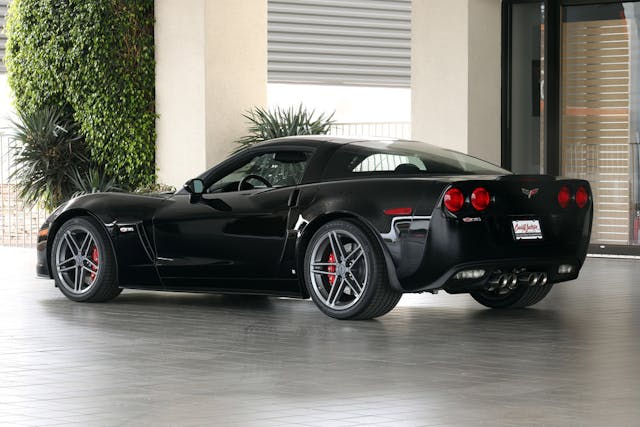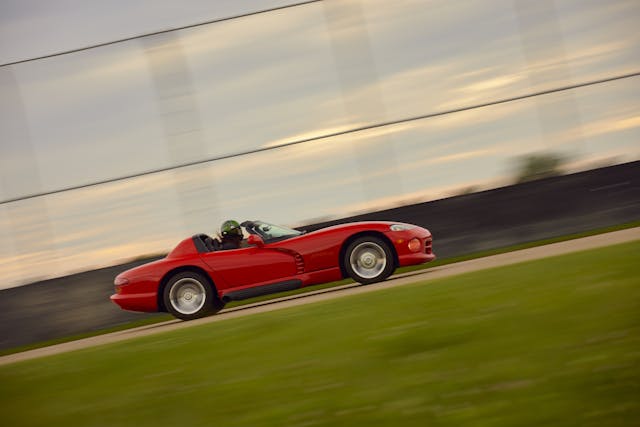Why enthusiasts love analog cars
Last year, vinyl records had their best year since 1987. Mechanical watches, tube amplifiers, and even film photography also continue to enjoy a resurgence. Analog tech is clearly having a moment. So why should low-tech cars be any different from records, amps, cameras, and watches?
In point of fact, they’re not—post-1990s analog cars are hitting their stride among a certain subset of collectors and enthusiasts. But what makes for an analog car, and why are people coming to appreciate them? Let’s just say that while the cars themselves may be simple, the answers to those questions are anything but.
There seems to be little consensus on what exactly fulfills the analog definition. The most hardcore enthusiasts will not abide any electronic drivers’ aids, like traction control or even ABS, while the more tolerant will accept those but draw the line at electric power steering, which they consider to be the work of the devil. Where enthusiasts do come together, however, is on the tactile delights of a good, old-fashioned, hydraulically assisted steering rack and, of course, the non-negotiable manual transmission.

Similarly, it’s hard to pinpoint the exact moment when analog cars gained the throwback quality that made them cherished outliers rather than the norm. Just as there was nothing novel about the vacuum tubes in a Carver or a McIntosh amplifier from the early 1960s, there was nothing remarkable about a C2 Corvette of the same vintage lacking ABS or traction control. There was, however, most assuredly something damned unusual about the 2005 Lotus Elise not having power steering, or the 2000 Dodge Viper lacking ABS. Those traits contributed to the Elise’s reputation for driving purity and the Viper’s rawness—even when new—and as a result few can quibble with those models being charter members of the late-analog car hall of fame.
Analog car fans can be incredibly geeky, to the point of near-snobbishness. For example, many single out the 1999 Porsche 911 as the last true analog 911—but it can’t be just any 1999 911. Nope, it has to be the Carrera 2, and not the all-wheel drive Carrera 4. Why, might you ask? Although both cars could be ordered without Porsche Stability Management (PSM), only the Carrera 2 came with an old-school cable-actuated throttle, whereas the Carrera 4 had an electronically controlled one. These folks have been known to split a few hairs.

Regardless, they are onto something. The more that digital-age assists make spirited driving easier—and further disconnect us from the task that got us excited about cars in the first place—the more people seem to revel in cars that lack that technology.
Case in point: two track events that I did a few years apart. The more recent of the two was at Road America in a then-new 991-generation Porsche 911 GT2 RS. The suite of driver’s aids on the car made blistering lap times available to mere mortals and superbly managed the car’s 690 hp. Did you get on the gas a little too soon exiting a corner? No problem, the car knew better: It overrode your hamfisted, premature throttle input until the front wheels were pointed straight. The car’s sophisticated electronics always made you feel like a hero, but deep down, you knew where the magic was coming from.

In contrast, years earlier, the Z06 Corvette I drove had far less sophisticated driver’s aids. It was an unrepentant oversteerer, unwilling to mask the mistakes of an unskilled driver. But, when you nailed all the inputs just so and rocketed out of a corner, your ear-to-ear grin came from knowing that little bit of perfection came from you working with the car. And that’s precisely the appeal. Lovers of analog cars want the visceral thrills—they want to take the risks and bask in the rewards.
Alongside renewed appreciation for driving these cars, the market seems to have jumped on the late-analog car bandwagon. Supercars that fit the analog moniker, like the Ferrari F40 and Porsche Carrera GT, are breaking records, but the trends aren’t just limited to the top of the market.
First-year 996-chassis Carrera 2s are now highly sought-after cars that have increased in value by 74 percent over the last five years. Early Dodge Vipers, after years of fairly static pricing, are firmly on the upswing. Values of my personal favorite late-analog car, the pretty and diminutive Lotus Elise, have followed a similar trajectory. Cars that were in the low $30,000 range a few years ago are now in the mid-forties, and likely to climb further. That’s no surprise—as it becomes more obvious that we’ll never see a new sports car with a curb weight under a ton again, people are flocking to the little British sports car. Simplicity doesn’t come cheap, unless it’s the perfect Elise substitute, the very analog Toyota MR2 Spyder. Don’t tell anyone.
At least as it applies to cars, “analog” is always going to be defined differently based on who you ask. But one thing’s for sure: as our automotive world becomes increasingly digital, the last generation of cars that offered a pure mechanical connection to the road will only grow in popularity.
***
Check out the Hagerty Media homepage so you don’t miss a single story, or better yet, bookmark it. To get our best stories delivered right to your inbox, subscribe to our newsletters.



Carver-named amps didn’t exist in the 1960’s. Even his first Phase Linear only appeared in ’72. Maybe you meant Crown.
I mentioned this on the previous appearance of this duplicate article having owner Carver and Sunfire amps.
Look cars are so computer complicated anymore these cars are gaining favor.
OBD1 and early OBDII cars are of great interest as they are easy to work on and modify. They have less nanny measures that jump in and do things you don’t always want done.
Right now cars like the one I just bought has minimal computer issues and it still runs a LS1 it is kind of the best of both worlds.
I can make changes easily and there are no auto braking, lane holding or other thing to mess with my drive. Hold the right buttons down I can kill off all the electronics.
There are those who just drive and those that like to build and modify. Well that is where I am and both my cars can take mods easy and it works fine.
That Z06 in the 4th pic is exactly the one I just sold a few months ago. I already miss it! Damn!
They are machines operated by a human, and the whole art of driving is the art of operating the machine well – something a lot of folks just don’t seem to get these days
Try heel/toeing in a car with power brakes. Nothing like manual steering and braking to get the real feel of the road. Manual transmissions are great fun on winding/hilly roads but not for people who live in the big city with all its associated heavy traffic making clutch work a bother. As I tell the sales person when looking for cars, I’m not old enough for an automatic transmission and it certainly is getting harder to find manuals. Some dealers tell you they don’t make them anymore even though the sales literature says they are available. I know several men and women who’ve walked away from potential sales to find a dealer that would get one in for them.
“I’m not old enough for an automatic transmission”?
A wee bit o’ ageism showing there, Alvanley? IMO, there is a place for both auto and manual trannies, at ANY age.
At 78, I’m still too young for automatic transmission !
I am only working on 72, but I am clearly an analog man living in a digital world.
It is odd that we are living at a time where ‘kids’ have been brought up knowing nothing other than technology yet are now seeking out dumb phones because they have an inability to put their phones away. We also live at a time with out of control distracted driving due to all of the technology. Ironically enough, the way to fix that is to take away all of the driver’s aids and electronic integration and make all transmissions manuals. You can’t text and drive when you are too busy shifting.
The only driver aid that I think we can say is a good addition to a vehicle is ABS. There is no good in having a car that won’t stop when you want to and crunches into something else. So personally for me, if it has ABS, that is a good thing (and I am coming from the perspective of having two cars that don’t have that). As far as anything else, its not needed or wanted. I haven’t ever even used cruise control once in my 23 years of driving.
Driving, not commuting, should be about working with and having a conversation with a machine to achieve a common goal. That is what non-car people don’t understand. They are just interested in getting from place a to b. They have no appreciation for what should be an enjoyable experience of getting there. Enjoy the ride.
Um, I’m not old enough for an automatic either and the stick doesn’t keep me from texting while driving it. Because I AM old enough for a flip phone which I can type on without looking at it.
Another reason for the desire for analog cars: their relative simplicity and ease of maintenance that the owner can perform in his garage. No expensive scan tool necessary.
This isn’t a reply… really… just a:
My first sportscar was an Austin-Healey BN1-L (the REAL Healey) bought used in (around) 1961. A fun car that kept blowing head gaskets. Talking to (by now) the dealer from whom I bought it, he allowed as how he’d take it back in trade on a S*T*U*N*N*I*N*G Jaguar XK120M in BRG that he had on the floor… Nanoseconds are defined as how long it took me to make that swap! Enjoyed it for several years—and it was reliable, allowing me to make several annual runs to Watkins Glen (then) for the USGP. (Probably cost about 100X that, now…)
I’ve had a couple of E-Types that I loved. Current vehicles that my pooch and I get around in: A Shelby Cobra with Ford Cleveland 351 hogged out to 359. Oh, and my Scion XB, 2005 vintage. Two great cars!
Analog at least gives the impression that it can be fixed where digital is too often disposable. And expedience often overrides adjerence to originality, hence the proliferation of small block Chevy motors used in Plymouths, Studebakers and so on, probably paving the way for electric conversions in the future.
Same with analog motorcycles. I have a ’97 Suzuki Bandit 1200 and I love it for its simplicity. It’s got what I want: a nice DOHC 16 valve engine, oil cooler, disc brakes front and rear, analog tach, speedo and fuel gauge, and relatively light weight (472 lbs dry). It’s not a rocket ship, but I plan on staying on earth :-). What it does have is lots of torque, good power, beautiful slick gearbox, simple air-cooled engine, and carburetors that I can fiddle with. And it handles well, even better with aftermarket suspension parts. Long live analog!
I recently purchased an ’84 Mustang 5 liter vert with a manual and do enjoy the simplicity. It still has its original Ford/Holley carb, so I’ve adjusted the float levels, choke and idle speed, and timing had been reset. Adjusted the door latch pins etc. No complicated controls (original radio and tape player) and a full set of easy to read analogue instruments so one can focus on driving. And of course there is that wonderful small block Ford sound as the tach passes 3500 rpm at WOT 😉 And yes I have a flip phone plus an amp and turntable.
I’m a believer in analog cars. Three of my cars are from 1999, two BMW e36s and an Oldsmobile. I have a 1990 Jeep Comanche, which is the perfect analog truck with all the comforts needed in a modern truck without all the junk you don’t need. Lastly I have a 62 Austin Healey Sprite which is the most brilliant analog fun. No power assistance and just plain excellent feel to the controls.
It’s great to work on them and know that if something breaks, it’s very likely I can fix it. Quite unlike the 2018 Jeep Grand Cherokee my parents purchased which has had endless infotainment issues that prevent major portions of the vehicle from working. Their most recent purchase was a BMW e38, the third one they have had, simply because they understand the car and know it’s going to work.
Analog cars – aren’t those the ones that the government and their corporate, ‘revolving door’ pals can’t track, follow, or snoop? Anybody, besides me, who demand ALL of our rights back?
A milestone, imho, came about when the military dropped the manual transmission from Humvee production due to so many ending up in the motorpool garages with burnt clutches, shredded syncros and gear sets resulting from the young gents who previously had no experience with such mechanisms.
As far as developing good car-control skills, ABS has been the bane of the last few generations of drivers. Learning the skill of controlling wheel lock-up with discrete pedal modulation based on steering and seat-of-the-pants feedback is all but impossible these days.
And remember learning how to use the e-brake to assist getting your manual trans car rolling from a stop when going up a steep hill?
Fact is, these newer generations have no interest in such skills now that technology performs what ae considered mundane tasks for them. Yes, there are many instances where these ‘assists’ are practical and useful. Yet, it’s obvious to those of us who are of a ‘certain’ age, that the competency level of most drivers today has befallen to a woefully low threshold. In a world where driving on public roads is practiced with the apparent acceptance of being far more focused on improving their ‘likes’ count on social media while holding a cellphone six inches in front one’s face, maybe we should applaud the technology that will stop the vehicle before running over the neighbor’s kid crossing the street with their face buried in a cellphone.
With my pining over the apparent unstoppable and exponential progress of tech, feel free to label me Luddite. I think of my grandparents grumbles about long hair boys, mini skirts and that abominable loud music; and now ponder how our perception of value evolves over time. And then a big grin begins to develop as I fondly reminisce some of the best driving experiences I have ever been graced with whilst in my ‘85 944.
90’s analog cars are gaining popularity for the feel that they have that todays cars do not have.